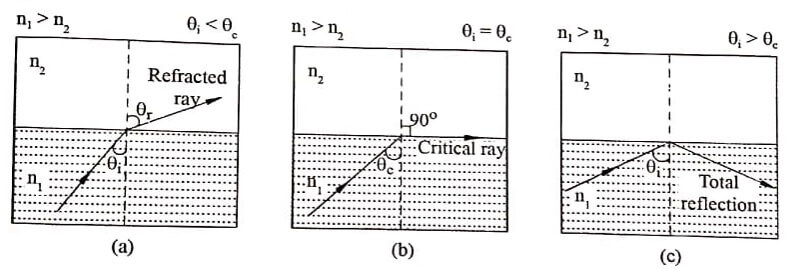Principle : The principle behind the transmission of light waves in an optical fibre is total internal reflection.
The phenomenon of total internal reflection takes place when it satisfies the following two conditions.
- Light should travel from denser medium to rarer medium. i.e., n1> n2
where, n1 – refractive index of denser medium (core), n2 -refractive index of rarer medium (cladding) - The angle of incidence should be greater than the critical angle. i.e., θi > θc
where, θi – angle of incidence, θc – critical angle.
Critical angle θc is defined as the value of the incident angle at which the angle of refraction is 90°.
Let the light ray travel from denser medium to rarer medium. The reflection and refraction at the interface is a result of the difference in the speed of light in two materials having different refractive indices.
Case (i) When θi < θc the ray is refracted into the rarer medium as shown in (Fig.1.1 a).
Case (ii) When θi = θc the ray travels along the interface so that the angle of refraction is 90° . This angle (θc) is called as critical angle as shown in (Fig.1.1b).
Case (iii) When , θi > θc the ray is totally reflected back into the denser medium itself as shown in (Fig. 1.1 c). This phenomenon is known as total internal reflection.
The angles of incidence θi and refraction θr are related to each other and to the refractive indices of the dielectrics by Snell’s law of refraction which is represented by the following equation.

When θi= θc, θr= 90° then by snell’s law,
![]()
![]()
![]()
( since , sin 90° = 1 )
![]()
Where θc is the critical angle n1 and n2 are the refractive indices of the denser and rarer medium respectively.

Propagation of light in optical fibres
For optical fibres, the process of propagation of light (optical signal) is simple, because the light wave enters at one end of the fibre and strikes the interface of the core and cladding only at large angles of incidence. The light beam undergoes total internal reflection and passes through the length of the cable.

Even for a bent fibre, the light guidance takes place by multiple total internal reflection all over the length of the fibre as shown in (Fig. 1.2).
Let us consider an optical fibre into which the light is injected. The light ray travels along AO and enters the core at an angle θa to the axis of the fibre.

Fig 1.3 Light propagation in optical fibre
- The light ray is refracted along OB at an angle θr in the core. It further proceeds to fall at critical angle of incidence θ = (90 -θr ) on the interface between core and cladding at B as shown in (Fig. 1.3).
- If θ is greater than the critical angle at the core cladding interface, the light ray gets total internally reflected and propagates through the fibre (i.e.,) the light will stay inside the fibre.
- Since it is the critical angle of incidence, the ray is refracted at 90° to the normal drawn to the interface (i.e,) it moves along BC.
- However, only light wave that enters at an angle of incidence greater than θa at O will ultimately be incident at B at an angle less than the critical angle. Due to this, it will be refracted into the cladding region and be absorbed by the cladding and hence it will be lost. Therefore, the angle θa i.e, maximum angle at or below which the light rays undergo total internal reflection is known as acceptance angle.
| Read More Topics |
| Three types of optical fibre |
| Fibre optical communication system |
| Medical application of laser |





